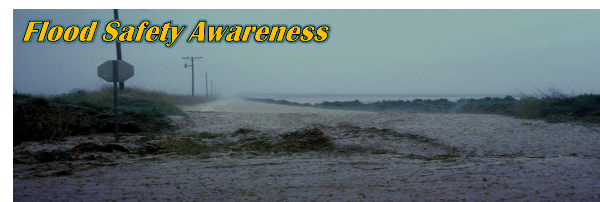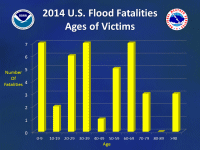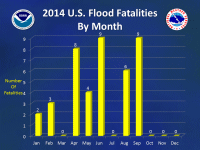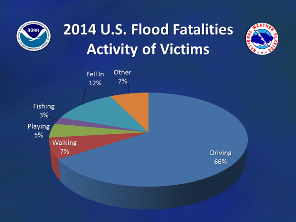 |
||||||||
|
||||||||
| Flood Safety is Everyone’s Business in the RGV |
||||||||
|
Flooding is America’s number one disaster, on average, costing billions of dollars and hundreds of lives annually. Nearly all cities and many towns have experienced flooding at one time or another. Welcome rains returned to the Rio Grande Valley during autumn 2013 and helped alleviate the long term drought. Most of the rains were beneficial, but on two occasions they were a little too helpful: On September 20th, at least 3 inches of rain filled arroyos in Starr County. The flowing water rose above bank full and flooded U.S. Highway 83 between Rio Grande City and Roma. Some of the floodwater reached into properties in Rio Grande City. On November 6th, a slow moving thunderstorm flooded West Brownsville with more than four inches of rain in a little over an hour; at least one vehicle had water up to the windshield and several businesses had some water in them. The first significant cold front of the season on November 22 dropped more than 6 inches of rain in Harlingen; an estimated 3 to 4 inches in Raymondville pushed several inches of water into City Hall. Drought and small scale flooding can coexist in the Rio Grande Valley. In 2012, despite another very dry year for many, there were two notable flood events. On March 29th, the devastating McAllen hailstorm also dropped four to six inches of rain which flooded much of the city. The floods submerged more than 100 vehicles and pushed the city’s intricate drainage and pumping system to 90 percent of capacity. On June 30th, nearly six inches of rain fell on Brownsville and flooded some areas with more than 2 feet of standing water. Rio Grande Valley residents should never let their flood guard down. It only seems like yesterday when flooding was a primary story in 2010, starting with a week long period of locally heavy rainfall April 12th through 18th that produced localized floods in Brownsville, McAllen, Mission, and Harlingen. Flooding affected the May 18th morning commute around McAllen, and persistent thunderstorms flooded Falfurrias on May 25th. These events were just a prelude to the big flood story of 2010, led off by Alex on June 30th and July 1st, and culminating with the Rio Grande Flood through July and August. Finally, the flood season finished in style, as mid September heavy rainfall flooded Cameron County. In 2008, the Rio Grande Valley was no stranger to flooding, either. Hurricane Dolly dropped more than a foot of rain on portions of Cameron and Willacy Counties during late July; another foot of rain fell in and near Roma (Starr County) between August 18th and 25th. In each case, hundreds, if not thousands, of structures were flooded, and water rescues of stranded residents were necessary. Click here for a short video of freshwater flooding in northeast Cameron County due to Hurricane Dolly. How will the rest of 2014 fare? Trends and teleconnections (i.e. El Niño/Southern Oscillation, Arctic/North Atlantic Oscillation, etc.) suggest that spring into early summer 2014 will gradually warm up and perhaps dry out. While it is to soon to forecast individual late and summer rain events, we must remember the Rio Grande Valley is in a river delta. The low lying landscape, combined with plenty of poor drainage areas, means that heavy rain in a short period of time can cause big problems – any time of year. Flooding and Fatalities In 2013, national non–tropical cyclone related flood deaths increased back toward the 30 year average (89), reaching 85. A number of individual events contributed to the increase, including the September Colorado Front Range Flood which killed six; the May 31st Oklahoma Flash Flood, which killed thirteen, and the Austin Area Halloween Floods, which killed seven. Tropical cyclones were a non–factor in 2013, as none made landfall close enough to the U.S. to create river or freshwater flooding. |
||||||||
 |
 |
|||||||
 |
 |
|||||||
|
The following statistics, not shown in the graphics above, were compiled for events recorded in Storm Data for direct flood related deaths, nationwide (including Puerto Rico), in 2014:
Stay safe this year! The following information, and links, can help you prepare for flooding - anytime, and anywhere. |
||||||||
|
|
||||||||
| Other Links
Safety Information
Know Your Risk
|
||||||||